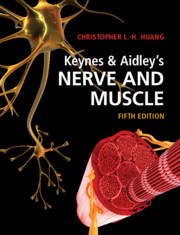Book contents
- Keynes & Aidley’s Nerve and Muscle
- Keynes & Aidley’s Nerve and Muscle
- Copyright page
- Dedication
- Contents
- Preface
- Acknowledgements
- Abbreviations used in the text
- 1 Structural Organisation of the Nervous System
- 2 Resting and Action Potentials
- 3 Background Ionic Homeostasis of Excitable Cells
- 4 Membrane Permeability Changes During Excitation
- 5 Voltage-Gated Ion Channels
- 6 Cable Theory and Saltatory Conduction
- 7 Neuromuscular Transmission
- 8 Synaptic Transmission in the Nervous System
- 9 The Mechanism of Contraction in Skeletal Muscle
- 10 The Activation of Skeletal Muscle
- 11 Excitation–Contraction Coupling in Skeletal Muscle
- 12 Contractile Function in Skeletal Muscle
- 13 Cardiac Muscle
- 14 Ion Channel Function and Cardiac Arrhythmogenesis
- 15 Smooth Muscle
- Further Reading
- References
- Index
4 - Membrane Permeability Changes During Excitation
Published online by Cambridge University Press: 07 November 2020
- Keynes & Aidley’s Nerve and Muscle
- Keynes & Aidley’s Nerve and Muscle
- Copyright page
- Dedication
- Contents
- Preface
- Acknowledgements
- Abbreviations used in the text
- 1 Structural Organisation of the Nervous System
- 2 Resting and Action Potentials
- 3 Background Ionic Homeostasis of Excitable Cells
- 4 Membrane Permeability Changes During Excitation
- 5 Voltage-Gated Ion Channels
- 6 Cable Theory and Saltatory Conduction
- 7 Neuromuscular Transmission
- 8 Synaptic Transmission in the Nervous System
- 9 The Mechanism of Contraction in Skeletal Muscle
- 10 The Activation of Skeletal Muscle
- 11 Excitation–Contraction Coupling in Skeletal Muscle
- 12 Contractile Function in Skeletal Muscle
- 13 Cardiac Muscle
- 14 Ion Channel Function and Cardiac Arrhythmogenesis
- 15 Smooth Muscle
- Further Reading
- References
- Index
Summary
The association between membrane excitation and alterations in membrane electrical impedance, its dependence on extracellular Na+ and the accompanying transmembrane Na+ fluxes measurable by isotope tracer methods, gave rise to the Na+ hypothesis for the action potential. Here, suprathreshold depolarising stimulation increases the voltage-dependent Na+ membrane conductance. The latter in turn initiates a regenerative cycle of membrane depolarisation and further channel opening, culminating in the action potential upstroke phase. Subsequent action-potential recovery to the resting potential then follows a voltage-dependent Na+ channel inactivation and more gradual K+ channel opening. This hypothesis was tested by voltage-clamp experiments determining the ionic currents required to drive depolarising membrane-potential steps in cephalopod giant axons from the resting to varying test levels. These revealed Na+ and K+ conductances whose voltage-dependences and kinetic properties could be incorporated into a successful mathematical reconstruction of the timecourse and properties of experimentally observed propagating action potentials.
Keywords
- Type
- Chapter
- Information
- Keynes & Aidley's Nerve and Muscle , pp. 41 - 54Publisher: Cambridge University PressPrint publication year: 2020

